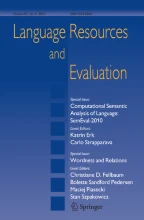Abstract
This paper is about the importance of applying computational modeling and artificial intelligence techniques to music cognition and computer music research. The construction of microworlds as a methodology plays a key role in the different stages of this research. Several uses of microworlds are described. Microworlds have been criticized in the domains of artificial intelligence and the cognitive sciences, but this critique has to be seen in its proper context (i.e. in modeling of human intelligence, not as a methodology). It is shown that the microworld approach is still an important methodology in music cognition and computer music research, and a promising strategy in the design of a general representation formalism of musical knowledge.
Similar content being viewed by others
References
Abelson, H. and A. diSessa.Turtle Geometry: Computation as Medium for Exploring Mathematics. Cambridge, MA: MIT Press, 1980.
Clarke, E.F. “Levels of Structure in the Organisation of Musical Time”. In “Music and Psychology: A Mutual Regard”. Ed. S. McAdams.Contemporary Music Review, 2, 1 (1987).
Desain, P. and H. Honing. “LOCO: A Composition Microworld in Logo.Computer Music Journal, 12, 3 (1988), 30–42.
Desain, P. and H. Honing.Music, Mind and Machine: Studies in Computer Music, Music Cognition and Artificial Intelligence. Amsterdam: Thesis Publishers, 1992a.
Desain, P. and H. Honing. “Towards a Calculus for Expressive Timing in Music”.Computers in Music Research. Vol. 3. 1992b. Also in Desain and Honing, 1992a.
Desain, P. and H. Honing. “Tempo Curves Considered Harmful”. In “Music and Time”. Ed. J. Kramer.Contemporary Music Review (forthcoming). Also in Desain and Honing, 1992a.
Dreyfus, H. “From Micro-Worlds to Knowledge Representation: AI at an Impasse”. InMind Design. Ed. J. Haugeland. Cambridge, MA: MIT Press, 1981, pp. 161–204.
Fodor, J.The Modularity of the Mind: An Essay on Faculty Psychology. Cambridge, MA: Bradford Books, MIT Press, 1983.
Friberg, A. L., Frydén, L. Bodin and J. Sundberg. “Performance Rules for Computer-Controlled Contemporary Keyboard Music”.Computer Music Journal, 15, 2 (1991).
Honing, H. “Expresso, a Strong and Small Editor for Expression”. InProceedings of the 1992 International Computer Music Conference. San Francisco: ICMA, 1992, pp. 215–18.
Honing, H. “Issues in the Representation of Time and Structure in Music”. InMusic and the Cognitive Sciences. Ed. I. Cross and I. Deliège.Contemporary Music Review. London: Harwood Press (1993). Also in Desain and Honing, 1992a.
Lenat, D. B. and E. A. Feigenbaum. “On the Thresholds of Knowledge”.Artificial Intelligence, 47 (1991), 185–250.
Longuet-Higgins, H.C. “Comments of the Lighthill Report”.Artificial Intelligence — A Paper Symposium. London: Science Research Council, 1973. Reprinted in Longuet-Higgins (1987).
Longuet-Higgins, H.C.Mental Processes. Cambridge, MA: MIT Press, 1987.
McCarthy, J. M. and P. J. Hayes. “Some Philosophical Problems from the Standpoint of Artificial Intelligence”. InReadings in Artificial Intelligence. Palo Alto: Tioga Publishing, 1981, pp. 431–50.
McCarthy, J. “We Need Better Standards for AI Research”. InThe Foundations of Artificial Intelligence. A Source Book. Ed. D. Partridge and Y. Wilks. Cambridge: Cambridge University Press, 1990, pp. 282–85.
Minsky, M., “Form and Content in Computer Science.” InACM Turing Award Lectures. Ed. R. L. Ashenhurst and S. Graham. Reading, MA: Addison-Wesley, 1987.
Palmer, C. “Mapping Musical Thought to Musical Performance”.Journal of Experimental Psychology: Human Perception and Performance, 15 (1989), 331–46.
Papert, S.Mindstorms. New York: Basic Books, 1980.
Repp, B. H., “Diversity and Commonality in Music Performance: An Analysis of Timing Microstructure in Schumann's “Traumerei”.Journal of the Acoustical Society of America, 92, 5 (1992), 2546–68.
Richie, G. D. and F. K. Hanna. “AM: A Case Study in AI Methodology”. InThe Foundations of Artificial Intelligence. A Source Book. Ed. D. Partridge and Y. Wilks. Cambridge: Cambridge University Press, 1990, pp. 247–65.
Smith, B. C. “The Owl and the Electric Encyclopedia”.Artificial Intelligence, 47 (1991), 251–88.
Winograd, T. and F. Flores.Understanding Computers and Cognition. A New Foundation for Design. Reading, MA: Addison-Wesley, 1987.
Winograd, T.Understanding Natural Language. New York: Academic Press, 1972.
Winograd, T. “Thinking Machines: Can there Be? Are We?” InThe Foundations of Artificial Intelligence. A Source Book. Ed. D. Partridge and Y. Wilks. Cambridge: Cambridge University Press, 1990, pp. 167–89.
Author information
Authors and Affiliations
Additional information
Henkjan Honing is research fellow at the University of Amsterdam, where he is doing research on the formalization of musical knowledge concentrating on time and temporal structure. With Peter Desain he wrote the bookMusic, Mind and Machine: Studies in Computer Music, Music Cognition and Artificial Intelligence.
Rights and permissions
About this article
Cite this article
Honing, H. A microworld approach to the formalization of musical knowledge. Comput Hum 27, 41–47 (1993). https://doi.org/10.1007/BF01830716
Issue Date:
DOI: https://doi.org/10.1007/BF01830716
